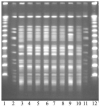The First Swedish Outbreak with VIM-2-Producing Pseudomonas aeruginosa, Occurring between 2006 and 2007, Was Probably Due to Contaminated Hospital Sinks
- PMID: 37110397
- PMCID: PMC10143745
- DOI: 10.3390/microorganisms11040974
The First Swedish Outbreak with VIM-2-Producing Pseudomonas aeruginosa, Occurring between 2006 and 2007, Was Probably Due to Contaminated Hospital Sinks
Abstract
Multidrug-resistant Pseudomonas aeruginosa is an increasing clinical problem worldwide. The aim of this study was to describe the first outbreak of a Verona integron-borne metallo-ß-lactamase (VIM)-2-producing P. aeruginosa strain in Sweden and its expansion in the region. A cluster of multidrug-resistant P. aeruginosa appeared at two neighbouring hospitals in 2006. The isolates were characterized by PCR, pulsed-field gel electrophoresis (PFGE), and whole-genome sequencing. Patient charts, laboratory records, and hygiene routines were reviewed, and patients, staff, and the environment were screened. The investigation revealed a clonal outbreak of a VIM-2-producing P. aeruginosa strain belonging to the high-risk clonal complex 111, susceptible only to gentamicin and colistin. No direct contact between patients could be established, but most of them had stayed in certain rooms/wards weeks to months apart. Cultures from two sinks yielded growth of the same strain. The outbreak ended when control measures against the sinks were taken, but new cases occurred in a tertiary care hospital in the region. In conclusion, when facing prolonged outbreaks with this bacterium, sinks and other water sources in the hospital environment should be considered. By implementing proactive control measures to limit the bacterial load in sinks, the waterborne transmission of P. aeruginosa may be reduced.
Keywords: MBL; Pseudomonas aeruginosa; VIM-2; nosocomial outbreak; sink.
Conflict of interest statement
The authors declare no conflict of interest. The funders had no role in the design of the study; in the collection, analyses, or interpretation of data; in the writing of the manuscript; or in the decision to publish the results.
Figures



Similar articles
-
Sink drains as reservoirs of VIM-2 metallo-β-lactamase-producing Pseudomonas aeruginosa in a Belgian intensive care unit: relation to patients investigated by whole-genome sequencing.J Hosp Infect. 2021 Sep;115:75-82. doi: 10.1016/j.jhin.2021.05.010. Epub 2021 Jun 8. J Hosp Infect. 2021. PMID: 34111433
-
Molecular evolution of metallo-beta-lactamase-producing Pseudomonas aeruginosa in a nosocomial setting of high-level endemicity.J Clin Microbiol. 2006 Jul;44(7):2348-53. doi: 10.1128/JCM.00258-06. J Clin Microbiol. 2006. PMID: 16825348 Free PMC article.
-
Metallo-beta-lactamase-producing Pseudomonas putida as a reservoir of multidrug resistance elements that can be transferred to successful Pseudomonas aeruginosa clones.J Antimicrob Chemother. 2010 Mar;65(3):474-8. doi: 10.1093/jac/dkp491. Epub 2010 Jan 12. J Antimicrob Chemother. 2010. PMID: 20071364
-
Molecular epidemiology of outbreak-related pseudomonas aeruginosa strains carrying the novel variant blaVIM-17 metallo-beta-lactamase gene.Antimicrob Agents Chemother. 2009 Apr;53(4):1325-30. doi: 10.1128/AAC.01230-08. Epub 2009 Jan 21. Antimicrob Agents Chemother. 2009. PMID: 19164147 Free PMC article.
-
Molecular epidemiology of carbapenem-resistant Pseudomonas aeruginosa in an endemic area: comparison with global data.Eur J Clin Microbiol Infect Dis. 2018 Jul;37(7):1211-1220. doi: 10.1007/s10096-018-3244-4. Epub 2018 Apr 11. Eur J Clin Microbiol Infect Dis. 2018. PMID: 29644540 Review.
Cited by
-
The Challenge of Overcoming Antibiotic Resistance in Carbapenem-Resistant Gram-Negative Bacteria: "Attack on Titan".Microorganisms. 2023 Jul 27;11(8):1912. doi: 10.3390/microorganisms11081912. Microorganisms. 2023. PMID: 37630472 Free PMC article. Review.
-
Prevalence of colistin resistance in clinical isolates of Pseudomonas aeruginosa: a systematic review and meta-analysis.Front Microbiol. 2024 Oct 9;15:1477836. doi: 10.3389/fmicb.2024.1477836. eCollection 2024. Front Microbiol. 2024. PMID: 39473844 Free PMC article.
References
-
- Knoester M., de Boer M.G., Maarleveld J.J., Claas E.C.J., Bernards A.T., de Jonge E., van Dissel J.T., Veldkamp K.E. An integrated approach to control a prolonged outbreak of multidrug-resistant Pseudomonas aeruginosa in an intensive care unit. Clin. Microbiol. Infect. 2014;20:O207–O215. doi: 10.1111/1469-0691.12372. - DOI - PubMed
-
- Van der Bij A.K., Van Mansfeld R., Peirano G., Goessens W.H.F., Severin J.A., Pitout J.D.D., Willems R., Van Westreenen M. First outbreak of VIM-2 metallo-beta-lactamase-producing Pseudomonas aeruginosa in The Netherlands: Microbiology, epidemiology and clinical outcomes. Int. J. Antimicrob. Agents. 2011;37:513–518. doi: 10.1016/j.ijantimicag.2011.02.010. - DOI - PubMed
-
- Suarez C., Peña C., Arch O., Dominguez M.A., Tubau F., Juan C., Gavaldá L., Sora M., Oliver A., Pujol M., et al. A large sustained endemic outbreak of multiresistant Pseudomonas aeruginosa: A new epidemiological scenario for nosocomial acquisition. BMC Infect. Dis. 2011;11:272. doi: 10.1186/1471-2334-11-272. - DOI - PMC - PubMed
-
- Jongerden I.P., Buiting A.G., Leverstein-van Hall M.A., Speelberg B., Zeidler S., Kesecioglu J., Bonten M.J. Effect of open and closed endotracheal suctioning on cross-transmission with Gram-negative bacteria: A prospective crossover study. Crit. Care Med. 2011;39:1313–1321. doi: 10.1097/CCM.0b013e3182120815. - DOI - PubMed
LinkOut - more resources
Full Text Sources
Miscellaneous

